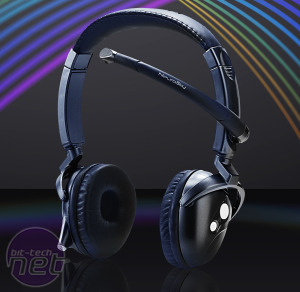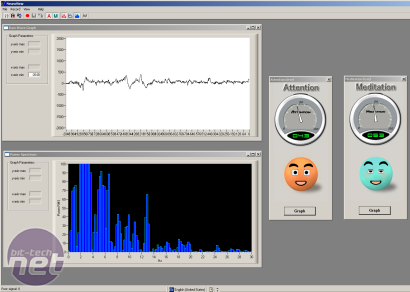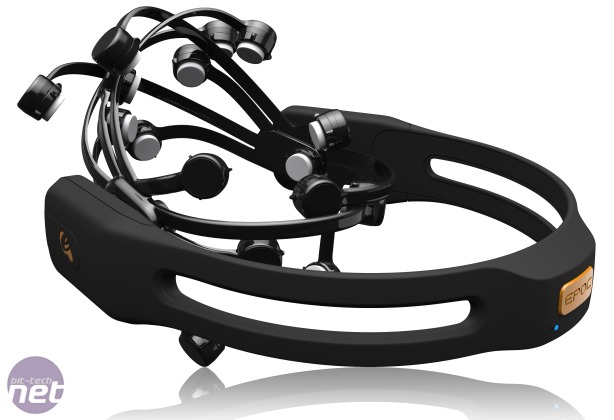
Control your PC with your mind
In a nondescript skyscraper near San Francisco, I am trying to set a barrel on fire just by thinking about it.I have been told the barrel will combust if I concentrate on it, but this turns out to be more difficult than it sounds.
I stare and squint.
I imagine attention projecting from my mind like a laser beam.
I sing a song in my head – apparently recalling lyrics is a way of evincing concentration. And I try not to be intimidated by two people sitting nearby, one of whom has just levitated a car. Finally, somehow, the barrel lifts into the air, sparks and fizzles, and then bursts into flame.
 This was not telekinesis, telepathy or even pyro-kinesis. The office belongs to Neurosky, one of a number of firms aiming to bring brainwave readers into widespread use. Companies in the gaming, health care, automobile and education sectors are devising applications, and even the U.S. national archery team are using the technology. Industry figures speak of a future in which machines respond to our minds, with cars that track the mental states of drivers and search engines that read images in a user’s head.
This was not telekinesis, telepathy or even pyro-kinesis. The office belongs to Neurosky, one of a number of firms aiming to bring brainwave readers into widespread use. Companies in the gaming, health care, automobile and education sectors are devising applications, and even the U.S. national archery team are using the technology. Industry figures speak of a future in which machines respond to our minds, with cars that track the mental states of drivers and search engines that read images in a user’s head. “It’s definitely the next generation of interface devices,” says Sara De Freitas, director of research at Coventry University’s Serious Games Institute. “I’m sure there will be a mass take-up.”
Still, as with any new technology, there are kinks to be worked out, and it remains to be seen whether it will enjoy broad popularity.
The current boom is based on an instrument that has been deployed in hospitals for decades – the electroencephalograph - aka the EEG. It is used to detect brainwaves, for example the alpha waves that generally correspond to relaxation, or the beta waves that indicate alertness. The new wave of firms has produced headsets that are essentially cheaper, easier-to-use versions of EEG machines, and also do not need gloopy conductive gel to operate. The Neurosky headset, for example, only has one sensor as opposed to around 20, and is thus slightly less accurate.
The devices work by first isolating the brain waves - they filter out electrical interference from man-made appliances and physical movements, such as blinking and the grinding of teeth. Then they map the brain waves to mental states, emotions or thoughts using proprietary algorithms - you can see the output from the headset being mapped to emotions in NeuroSky's software in the image to the left.
 These algorithms are highly sophisticated. They must cut through the idiosyncrasies of individual brains and hone in on the subtle signals that every person produces when they experience a particular state.
These algorithms are highly sophisticated. They must cut through the idiosyncrasies of individual brains and hone in on the subtle signals that every person produces when they experience a particular state.“It’s really a black magic,” says Neurosky CEO Stanley Yang. “We had to test them in all kinds of conditions, on people of different racial backgrounds, different age groups, indoors, outdoors.” Neurosky tried its algorithms on thousands of subjects.
The company’s technology currently identifies two mental states: being focused and being relaxed. Toys or games using Neurosky headsets require players to produce these mental states to make something happen. For example, players of a 2009 Mattel toy move a ball around an obstacle course by varying their concentration levels. The ball is held aloft by a jet of air. Focus more and the ball rises. Focus less and it falls.
A San Francisco firm named Emotiv, whose headset has 14 sensors and is more sensitive than Neurosky’s, takes a different approach. At first blush it does not sound far from telepathy. First-time users of Emotiv games are asked to undergo a training session so the software can adapt itself to the player’s mind. Once the software has pinned down the patterns that occur when, say, the person thinks of moving left, the player should be able to move left in a game just by thinking of it.
“Training to move an object is awesomely fast,” says Emotiv co-founder Nam Do. The company estimates that most people could begin moving objects on computer screens after two six-second training sessions. It says companies including Boeing, Samsung and Honda are working with its headsets.

MSI MPG Velox 100R Chassis Review
October 14 2021 | 15:04









Want to comment? Please log in.